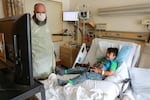
OHSU patient Chance Wischnofske gets in some quality gaming time on the new XBOX that was recently donated to OHSU Doernbecher Children's Hospital by Games for Love. Chance's favorite game to play is Minecraft and Minecraft Dungeons. He loves it when Samuel Giles Le Blanc comes by to play alongside. Samuel Giles Le Blanc is a patient technology specialist at OHSU Doernbecher Children's Hospital.
Courtesy of Christine Torres Hicks / OHSU
A hospital stay can be a scary experience for anyone, but perhaps especially for young people.
Kids and teens who have extended stays in the hospital are often sitting by themselves in their beds, while doctors and nurses occasionally come in to check on their vitals, which can be a lonely experience.
At Oregon Health & Science University, one man is finding a playful way to level up their stay.
Every day, Sam Giles LeBlanc walks the halls of OHSU’s Doernbecher Children’s Hospital and checks in on his young patients. But he’s not checking on their medical needs.
“I’ll knock on doors and ask kids, are your gaming-related needs being met?” he says.
And by gaming — he means video games. Giles LeBlanc has been a gamer his entire life.
“I’ve been playing video games since I was 3 years old. My mom actually sent me a picture of me holding an Atari 2600 controller, and I wanna say it was 1982,” he laughs.

Sam Giles Le Blanc is Doernbecher’s patient technology specialist (“the video game guy”). He manages the therapeutic gaming program, a new addition to Doernbecher’s Child Life Therapy Program.
Courtesy of Christine Torres Hicks / OHSU
As head of OHSU’s Therapeutic Gaming Program, Giles LeBlanc knows the value video games play in helping children cope with stressful places like hospitals.
“If you’re stuck in a hospital bed all day every day,” he explains, “then to have this feeling of a whole world that you can explore, you know, it’s like books, but on a different level because you’re personally exploring that world.”
Sometimes it’s simple. If a child wants to play an Xbox or a Playstation, he’ll wheel in a station, complete with a console and TV screen.
“Other times though, the child may say they want someone to play with. And that means that I’ll sit there and spend a lot of time playing games with the kid.”
For decades, the impact of video games on children’s development has often been misunderstood. A common stigma with video games is that they will damage a child’s brain, or hinder their social development.
But last year, the American Medical Association released evidence demonstrating that video games may in fact improve children’s cognitive and social skills.
Travis Ericksen, the executive director of the video game nonprofit Child’s Play, believes video games have proven benefits during medical treatment.
“There is research out there that shows that games can help reduce pain because they can distract you from that pain. They can reduce anxiety. They can lower that anxious feeling that you have,” says Ericksen.
Linh Doan’s son Max, 10, spent a little time at Doernbecher when he was 5, and again at 8, and she saw how video games can help with recovery.
During both stints, Doan wanted to focus on Max’s recovery so he could leave as quickly as possible, so they never used the video game therapy program. But she said the program inspired the family to try video games at home.
“He’s doing really well. He’s probably addicted to Minecraft,” says Doan.
Video games also helped Max reconnect with friends from the safety of his house.
“He’s a lot more interactive playing with other kiddos and understanding how to ask and what he does in the game with his friends. I think that’s a good thing,” she said.
Sam Giles LeBlanc took over the video game therapy program last year. At the time, the program had a few games on hand, but the medical staff were usually too busy to play video games with the kids.
That’s where Sam came in. His extensive video game knowledge gave him the opportunity to take note of what the program needed to thrive. His first step — securing funding.
By building a support network with nonprofit organizations like Child’s Play, Giles LeBlanc eventually raised enough money to curate and purchase a list of child and family-friendly video games and consoles.
“You want to have Minecraft on every single rig,” he said.
Minecraft is an open-world game where kids can build whatever they want with colorful, digital Lego-style blocks. For example, they can build their own castle or city. All that matters is that the children use their boundless imagination and creativity to build whatever they want.
“We got some games that are fun cooperative games like Overcooked! 2.”
Overcooked! 2 is the sequel to the wildly popular cooperative game Overcooked! in which teams work together to cook and serve food in a kitchen.
“That’s the kind of game that even a parent who has never played a video game before could jump in and play,” he says.

OHSU patient Lucas Alcantara says he enjoys playing video games while staying in the hospital. His favorite game is Minecraft Dungeons on the new XBOX that was recently donated to OHSU Doernbecher Children's Hospital by Games for Love.
Courtesy of Christine Torres Hicks / OHSU
Rebekah Coles manages OHSU’s Child Life Therapy program, where the Therapeutic Gaming Program is housed.
Coles works with volunteers to provide the kids with enough activities to keep them happy. Sometimes that includes board games, or volunteer musicians, or even dedicated bingo nights.
But she noticed that Sam’s therapeutic video game program is the most popular. Coles attributes that popularity to his jovial personality and ability to connect to the children.
“Sam is one of the most gracious people that I know. He is one of the most kind people that I know, and he is a ton of fun. I don’t know that we’ll ever find another Sam if he ever leaves us,” says Coles.
Giles LeBlanc wants to eventually level up the program to the point where children in separate rooms can play with each other online, but he says he’s not quite there yet.
“We’re pretty cautious about online gaming here. So we do not want to expose our patients to the many negative things that come with online gaming,” he says. “Man, I’d love nothing more than connect all our patients together and build something, you know, that’d be fun.”
He says he’s gotten a ton of support from the medical staff as well as parents like Linh Doan.
“Seeing how much Max’s gone through, how much he’s endured, we’re talking about a child who used to be very friendly and walks up to anyone. To not be able to do that, and then coming back again, that’s really huge,” says Doan.
As for Giles LeBlanc, he’s just happy seeing the young patients having much-needed fun.
“I am not a medical expert but I don’t think you need to be to see the good that comes from this.”


